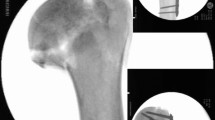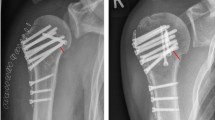Abstract
Purpose
Carbon-fibre reinforced polyetheretherketone (CFR-PEEK) plates have recently been introduced for proximal humerus fracture treatment. The purpose of this study was to compare the locking screw-plate interface stability in CFR-PEEK versus stainless steel (SS) proximal humerus plates.
Methods
Locking screw mechanical stability was evaluated independently in proximal and shaft plate holes. Stiffness and load to failure were tested for three conditions: (1) on-axis locking screw insertion in CFR-PEEK versus SS plates, (2) on-axis locking screw insertion, removal, and reinsertion in CFR-PEEK plates, and (3) 10-degree off-axis locking screw insertion in CFR-PEEK plates. Cantilever bending at a rate of 1 mm/minute was produced by an Instron machine and load-displacement data recorded.
Results
Shaft locking screw load to failure was significantly greater in CFR-PEEK plates compared to SS plates (746.4 ± 89.7 N versus 596.5 ± 32.6 N, p < 0.001). The stiffness and load to failure of shaft locking screws was significantly decreased when inserted 10 degrees off-axis compared to on-axis in CFR-PEEK plates (p < 0.001). Stiffness and load to failure did not vary significantly following screw reinsertion in CFR-PEEK plates.
Conclusion
The mechanical stability of locking screws in CFR-PEEK plates is comparable or superior to locking screws in SS plates.


Similar content being viewed by others
References
Kurtz SM, Devine JN (2007) PEEK biomaterials in trauma, orthopedic, and spinal implants. Biomaterials 28:4845–4869
Steinberg EL, Rath E, Shlaifer A, Chechik O, Maman E, Salai M (2013) Carbon fiber reinforced PEEK optima—A composite material biomechanical properties and wear/debris characteristics of CF-PEEK composites for orthopedic trauma implants. J Mech Behav Biomed Mater 17:221–228
Hak DJ, Mauffrey C, Seligson D, Lindeque B (2014) Use of carbon-fiber-reinforced composite implants in orthopedic surgery. Orthopedics 37:825–830
Rotini R, Cavaciocchi M, Fabbri D, Bettelli G, Catani F, Campochiaro G, Fontana M, Colozza A, De Biase CF, Ziveri G, Zapparoli C, Stacca F, Lupo R, Rapisarda S, Guerra E (2015) Proximal humeral fracture fixation: multicenter study with carbon fiber peek plate. Musculoskelet Surg 99(Suppl 1):S1–S8
Schliemann B, Hartensuer R, Koch T, Theisen C, Raschke MJ, Kösters C, Weimann A (2015) Treatment of proximal humerus fractures with a CFR-PEEK plate: 2-year results of a prospective study and comparison to fixation with a conventional locking plate. J Shoulder Elb Surg 24:1282–12883
Kääb MJ, Frenk A, Schmeling A, Schaser K, Schütz M, Haas NP (2004) Locked internal fixator: sensitivity of screw/plate stability to the correct insertion angle of the screw. J Orthop Trauma 18:483–487
Schliemann B, Seifert R, Theisen C, Gehweiler D, Wähnert D, Schulze M, Raschke MJ, Weimann A (2017) PEEK versus titanium locking plates for proximal humerus fracture fixation: a comparative biomechanical study in two- and three-part fractures. Arch Orthop Trauma Surg 137(1):63–71
Maldonado ZM, Seebeck J, Heller MO, Brandt D, Hepp P, Lill H, Duda GN (2003) Straining of the intact and fractured proximal humerus under physiological-like loading. J Biomech 36(12):1865–1873
Gardner MJ, Nork SE, Huber P, Krieg JC (2010) Less rigid stable fracture fixation in osteoporotic bone using locked plates with near cortical slots. Injury 41(6):652–656
Lill H, Hepp P, Korner J, Kassi JP, Verheyden AP, Josten C, Duda GN (2003) Proximal humeral fractures: how stiff should an implant be? A comparative mechanical study with new implants in human specimens. Arch Orthop Trauma Surg 123(2–3):74–81
Bottlang M, Doornink J, Byrd GD, Fitzpatrick DC, Madey SM (2009) A nonlocking end screw can decrease fracture risk caused by locked plating in the osteoporotic diaphysis. J Bone Joint Surg Am 91(3):620–627
Perren SM (2002) Evolution of the internal fixation of long bone fractures. The scientific basis of biological internal fixation: choosing a new balance between stability and biology. J Bone Joint Surg Br 84(8):1093–1110
Bottlang M, Lesser M, Koerber J, Doornink J, von Rechenberg B, Augat P, Fitzpatrick DC, Madey SM, Marsh JL (2010) Far cortical locking can improve healing of fractures stabilized with locking plates. J Bone Joint Surg Am 92(7):1652–1960
Bottlang M, Tsai S, Bliven EK, von Rechenberg B, Kindt P, Augat P, Henschel J, Fitzpatrick DC, Madey SM (2017) Dynamic stabilization of simple fractures with active plates delivers stronger healing than conventional compression plating. J Orthop Trauma 31(2):71–77
Acknowledgements
The Carbo-Fix plates and screws used in their study were obtained through a grant from Invibio (Lancashire, UK). Synthes (West Chester PA, USA) provided the stainless steel plates and screws used in this study.
Author information
Authors and Affiliations
Corresponding author
Ethics declarations
Conflicts of interests
Dr. Hak serves as a paid consultant for Invibio Inc. Mr. Baldini has received financial support from SMV Scientific and Stryker Endoscopy, outside of the presented work. All other authors have no relevant financial relationships.
Rights and permissions
About this article
Cite this article
Hak, D.J., Fader, R., Baldini, T. et al. Locking screw-plate interface stability in carbon-fibre reinforced polyetheretherketone proximal humerus plates. International Orthopaedics (SICOT) 41, 1735–1739 (2017). https://doi.org/10.1007/s00264-017-3562-7
Received:
Accepted:
Published:
Issue Date:
DOI: https://doi.org/10.1007/s00264-017-3562-7




